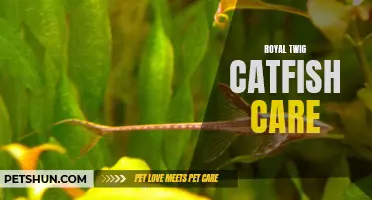
Are you a fan of exotic and unique freshwater fish? If so, you'll definitely want to check out the Asian red tail catfish! This fascinating species, native to Southeast Asia, is known for its vibrant red tail and impressive size. In this care sheet, we'll explore everything you need to know about keeping an Asian red tail catfish as a pet. From tank setup to feeding and maintenance, we've got you covered. Get ready to dive into the world of this stunning fish and discover what it takes to provide it with a happy and healthy home.
| Characteristics | Values |
|---|---|
| Scientific Name | Hemibagrus wyckii |
| Common Names | Asian red tail catfish, Ripsaw catfish |
| Origin | Southeast Asia |
| Size | Up to 3 feet (90 cm) |
| Lifespan | 10-15 years |
| Water Parameters | pH: 6.0-7.5, Temperature: 75-82°F (24-28°C), Hardness: Soft to moderately hard |
| Tank Size | Minimum of 250 gallons (946 liters) for adults |
| Tank Setup | Provide hiding spots with caves, rocks, and plants. Sand or fine gravel substrate. Adequate filtration is crucial. |
| Diet | Carnivorous, feed with a variety of live or frozen foods such as fish, shrimp, and worms. |
| Behavior | Nocturnal, can be aggressive and territorial. |
| Compatibility | Best kept alone or with large, robust tank mates. |
| Breeding | Difficult in captivity, requires specialized conditions. |
| Care Level | Intermediate |
| Common Health Issues | Diseases caused by poor water quality, parasites, and bacterial infections. |
| Special Considerations | Handle with care as they have sharp spines on their pectoral fins. Provide adequate space and filtration due to their size and waste production. |
What You'll Learn
- What are the specific care requirements for an Asian red tail catfish?
- How large do Asian red tail catfish grow, and what size tank do they need?
- What is the recommended diet for Asian red tail catfish?
- Are there any specific water parameters that need to be maintained for these catfish?
- What are some common health issues or diseases that Asian red tail catfish are prone to, and how can they be prevented or treated?

What are the specific care requirements for an Asian red tail catfish?
Asian red tail catfish, also known as Hemibagrus wyckii or Cephalopara wyckii, is a popular fish among freshwater aquarium enthusiasts. They are native to Southeast Asia, including Thailand, Malaysia, and Borneo. Due to their vibrant red coloration and impressive size, they are often sought after by experienced fish keepers. However, like any other pet, Asian red tail catfish require specific care to thrive in captivity.
One of the primary considerations when caring for an Asian red tail catfish is the size of the aquarium. These fish can grow up to 4 feet in length, so a large tank is essential. A tank with a capacity of at least 200 gallons is recommended to provide enough space for the catfish to swim and thrive. The tank should also be equipped with a strong filtration system to maintain optimal water quality.
Water temperature and chemistry are crucial factors in the well-being of Asian red tail catfish. They prefer a temperature range of 74-82°F (23-28°C) and a pH level between 6.5 and 7.5. It is essential to regularly monitor and maintain these parameters to ensure the health of the fish. Water changes should be performed regularly to remove toxins and maintain the required conditions.
In terms of diet, Asian red tail catfish are carnivorous and require a high-protein diet. They can be fed a variety of meaty foods such as shrimp, fish fillets, and sinking pellets specifically formulated for large predatory fish. It is important to avoid overfeeding, as this can lead to obesity and health problems. Feeding once or twice a day, with portions that can be consumed within 5 minutes, is generally sufficient.
Compatibility with tankmates is another important consideration when keeping Asian red tail catfish. They can be aggressive towards smaller fish and may see them as potential prey. Therefore, it is best to keep them with larger, robust species that can hold their ground. Tank mates such as other large catfish, cichlids, or barbs are suitable choices. However, it is always advisable to research and understand the compatibility of different fish species before introducing them to the same tank.
Asian red tail catfish are known to be territorial and may require plenty of hiding spots in their aquarium. Providing caves, driftwood, and plants will create a sense of security for the fish. Additionally, these catfish are notorious jumpers, so a tight-fitting lid or cover is necessary to prevent them from escaping the tank.
Lastly, monitoring the health and behavior of the Asian red tail catfish is crucial. Any signs of illness or abnormal behavior, such as loss of appetite, lethargy, or abnormal swimming patterns, should be addressed promptly. Regular water testing, observation, and timely intervention can help prevent potential health issues and ensure a happy and thriving aquatic environment.
In conclusion, caring for an Asian red tail catfish requires a large aquarium, optimal water conditions, a suitable diet, compatible tankmates, and a secure environment. By providing these specific care requirements, fish keepers can enjoy the beauty and vitality of these impressive fish in their home aquarium.
A Guide to Caring for African Butter Catfish
You may want to see also

How large do Asian red tail catfish grow, and what size tank do they need?
Asian red tail catfish (Hemibagrus wyckioides) are one of the largest freshwater catfish species in the world. They can grow to a very impressive size, reaching lengths of up to 5 to 6 feet and weighing over 100 pounds. Due to their size and their active nature, they require a large tank to thrive in captivity.
When it comes to keeping Asian red tail catfish, it's important to have a tank that is big enough to accommodate their size. A general rule of thumb is to provide at least 1 gallon of water per inch of the fish's length. So if you have a 5-foot Asian red tail catfish, you would need a tank that holds at least 300 gallons of water.
A larger tank is always better, as it provides more swimming space for the fish and allows for better water quality. These catfish produce a lot of waste, so having a larger tank with a robust filtration system is essential to maintain good water quality.
In addition to the size of the tank, it's also important to consider the tank's dimensions. Asian red tail catfish are bottom-dwelling fish, so they require a tank with a large footprint rather than a tall tank. A tank that is longer and wider rather than taller is ideal for these catfish. This will ensure that they have plenty of space to swim and explore the bottom of the tank.
Another factor to consider when setting up a tank for Asian red tail catfish is the tank's decor. These catfish are often found in rivers and streams with a sandy or muddy substrate, so it's best to replicate this environment in the tank. Adding a layer of sand or fine gravel to the bottom of the tank will provide a natural substrate for the catfish to sift through.
It's also important to provide plenty of hiding places for these catfish. This can be done by adding rocks, driftwood, or PVC pipes to the tank. These hiding places will not only give the catfish a sense of security but also provide them with spots to rest and observe their surroundings. Having a well-decorated tank will help create a more natural and stimulating environment for these fish.
Feeding Asian red tail catfish can be quite a challenge due to their large size. These catfish are predators and will eat a variety of foods, including live, frozen, and prepared foods. However, it's important to make sure they are getting a balanced diet that includes a mix of protein-rich foods such as fish, shrimp, and worms, as well as some plant matter. It's also important to feed them in small, frequent meals rather than one large meal to prevent overeating and digestive issues.
In conclusion, Asian red tail catfish are impressive fish that require a large tank to thrive. A tank that holds at least 1 gallon of water per inch of the fish's length is recommended, with a large footprint and plenty of hiding places. Providing a varied and balanced diet is also key to keeping these fish healthy and happy in captivity. With the right setup and care, Asian red tail catfish can be a fascinating addition to any large freshwater aquarium.
The Complete Guide to Caring for Upside Down Catfish: Tips and Advice
You may want to see also

What is the recommended diet for Asian red tail catfish?
The Asian redtail catfish (Hemibagrus nemurus) is a popular species of freshwater catfish that is native to Southeast Asia. It is known for its vibrant red tail fin, which gives it its common name. In order to ensure the health and growth of this species, it is important to provide it with a balanced diet.
The recommended diet for Asian redtail catfish consists of a variety of foods that replicate their natural diet in the wild. In their natural habitat, these catfish are opportunistic feeders and consume a wide range of prey items, including small fish, crustaceans, insects, and plant matter. Therefore, their diet in captivity should include a mixture of protein-rich foods, such as feeder fish and shrimp, as well as plant-based foods like vegetables and fruits.
Protein is an essential component of the Asian redtail catfish's diet, as it supports their growth and overall health. Feeder fish, such as guppies or goldfish, are commonly used to provide the necessary protein. When feeding feeder fish, it is important to ensure that they are of the appropriate size for the catfish to consume easily. Live or frozen feeder fish can be offered, but it is crucial to avoid using feeder fish that have been treated with antibiotics or other medications, as they can be harmful to the catfish.
In addition to feeder fish, shrimp can also be a valuable protein source for Asian redtail catfish. Shrimp can be offered in its whole form, or it can be chopped into smaller pieces to make it easier for the catfish to eat. It is recommended to use high-quality, untreated shrimp to avoid any potential health risks.
While the catfish primarily consume animal protein, it is also important to include plant-based foods in their diet. Vegetables and fruits can provide essential vitamins and minerals, as well as fiber. Some suitable plant-based options include blanched peas, spinach, cucumber, and zucchini. These foods can be chopped into small pieces and offered as part of the catfish's regular feeding routine.
Feeding frequency will vary depending on the age and size of the catfish. Younger catfish may require multiple feedings per day, while adult catfish can be fed once or twice daily. It is important to monitor the catfish's feeding behavior and adjust the amount of food accordingly to prevent overfeeding, which can lead to obesity and health issues.
In conclusion, the recommended diet for Asian redtail catfish consists of a mixture of protein-rich foods, such as feeder fish and shrimp, as well as plant-based foods like vegetables and fruits. Feeding frequency should be adjusted according to the age and size of the catfish, and it is important to avoid overfeeding to maintain their health and well-being. By providing a balanced diet, cat owners can ensure the optimal growth and vitality of their Asian redtail catfish.
The 4 Keys to Proper Catfish Care: A Guide for Responsible Owners
You may want to see also

Are there any specific water parameters that need to be maintained for these catfish?
When it comes to keeping catfish, it's important to ensure that their water conditions are suitable for their health and well-being. Different species of catfish have different preferences for water parameters, so it's essential to research specific requirements before adding them to your aquarium.
One of the most crucial parameters to monitor is the temperature of the water. Most catfish species prefer slightly warmer water, with temperatures ranging from 72 to 82 degrees Fahrenheit. However, there are exceptions, so it's vital to check the specific temperature needs for the catfish species you plan to keep. Using a reliable aquarium thermometer will help you maintain a consistent temperature within the desired range.
Another important water parameter to consider is the pH level. Most catfish species prefer water with a pH range of 6.5 to 7.5. However, some species, such as the South American Corydoras, prefer a slightly lower pH range of 6.0 to 7.0. To maintain optimal pH levels, you can use a pH testing kit and adjust the pH as necessary using appropriate chemicals or natural methods, such as adding driftwood or peat moss.
Catfish also require good water quality, which means monitoring ammonia, nitrite, and nitrate levels. These substances can be toxic to fish if they accumulate in high concentrations. Regular water testing will help you ensure that these levels are within acceptable ranges. Performing regular water changes, maintaining a well-functioning filtration system, and avoiding overfeeding can help keep these levels in check.
Furthermore, it's essential to provide proper aeration and filtration to maintain a healthy aquarium environment for catfish. Adequate oxygenation is crucial for their well-being, as inadequate oxygen levels can stress the fish and lead to health problems. Using air stones, powerheads, or a well-designed filtration system can help ensure sufficient oxygenation and water movement in the tank.
Additionally, the hardness of the water can play a role in the health of catfish. Some species, like the African catfish, prefer harder water, while others, such as Otocinclus catfish, thrive in softer water. Hardness can be easily measured using test kits, and if necessary, adjusted through the addition of minerals or the use of a water conditioner.
It's also important to note that the size of the tank and the number of catfish you plan to keep can affect water parameters. Overstocking or overcrowding can lead to poor water conditions and stress for the fish. It's recommended to research and follow appropriate stocking guidelines for the specific species of catfish you plan to keep.
In conclusion, maintaining specific water parameters is crucial for the health and well-being of catfish. Temperature, pH, water quality, aeration, filtration, hardness, and stocking density are all important factors to consider. By researching the requirements of the specific catfish species and regularly monitoring and adjusting water parameters, you can provide a suitable environment for your catfish to thrive.
The Ultimate Guide to Ghost Catfish Care: Everything You Need to Know
You may want to see also

What are some common health issues or diseases that Asian red tail catfish are prone to, and how can they be prevented or treated?
Asian red tail catfish (Hemibagrus nemurus) are a popular species of fish that are often kept in home aquariums. While they can be beautiful and fascinating pets, it is important to be aware of some common health issues or diseases that they may be prone to. By understanding these issues and taking steps to prevent or treat them, you can ensure the health and well-being of your Asian red tail catfish.
One common health issue that Asian red tail catfish may face is bacterial infections. These infections can occur if the water quality in the aquarium is poor, or if the fish becomes stressed or injured. Signs of a bacterial infection may include redness, swelling, and open sores on the fish's body. To prevent bacterial infections, it is important to maintain good water quality by regularly cleaning the tank and monitoring the levels of ammonia, nitrite, and nitrate. It is also important to provide a stress-free environment for your fish and to handle them gently to avoid injuring them.
If you notice signs of a bacterial infection in your Asian red tail catfish, it is important to treat it promptly. One common treatment option is the use of antibiotics. There are several different antibiotics that can be used to treat bacterial infections in fish, and your veterinarian can recommend the best option for your specific situation. It is important to follow the instructions provided by your veterinarian and to continue the treatment for the full duration recommended, even if the symptoms improve.
Another health issue that Asian red tail catfish may face is parasitic infections. These infections can occur if the fish comes into contact with parasites in the water or if it ingests infected food. Signs of a parasitic infection may include scratching or rubbing against objects in the tank, loss of appetite, and changes in behavior. To prevent parasitic infections, it is important to quarantine any new fish before introducing them to your tank, as this can help to prevent the spread of parasites. It is also important to provide a clean and well-maintained environment for your fish, as parasites thrive in dirty or stagnant water.
If you suspect that your Asian red tail catfish has a parasitic infection, it is important to seek treatment promptly. There are several different medications available that can effectively treat parasitic infections in fish, and your veterinarian can recommend the best option for your specific situation. It is important to carefully follow the instructions provided with the medication, as well as any additional advice or recommendations from your veterinarian.
In addition to bacterial and parasitic infections, Asian red tail catfish may also be prone to certain dietary deficiencies or diseases. For example, some fish may develop vitamin deficiencies if they are not provided with a balanced diet that includes a variety of foods. Signs of a dietary deficiency may include faded coloration, loss of appetite, and changes in behavior. To prevent dietary deficiencies, it is important to provide your fish with a varied and balanced diet that includes a mixture of commercially-prepared fish foods, live or frozen foods, and fresh vegetables. You may also consider adding vitamin or mineral supplements to your fish's diet, but it is important to consult with your veterinarian before doing so.
If you suspect that your Asian red tail catfish has a dietary deficiency or disease, it is important to seek advice from your veterinarian. They can help to diagnose the issue and recommend any necessary dietary changes or supplements.
Overall, it is important to be aware of the potential health issues and diseases that Asian red tail catfish may be prone to. By taking steps to prevent these issues, such as maintaining good water quality, providing a stress-free environment, and offering a varied and balanced diet, you can help to ensure the health and well-being of your fish. If any health issues do arise, it is important to seek veterinary advice promptly, as early intervention can often lead to a more successful outcome.
The Essential Guide to Otocinclus Catfish Care: A Aquarium Owner's Manual
You may want to see also
Frequently asked questions
Asian Red Tail Catfish require a very large tank, as they can grow to be quite large. A tank that is at least 200 gallons is recommended to accommodate their size and provide enough swimming space.
Asian Red Tail Catfish prefer slightly acidic water with a pH range of 6.5-7.5. They also need clean, well-oxygenated water, so a good filtration system is essential. The water temperature should be kept between 75-82 degrees Fahrenheit.
Asian Red Tail Catfish are opportunistic predators and can eat a variety of foods. They will readily eat live or frozen fish, shrimp, and other similar meaty foods. It is important to provide a varied diet to ensure they receive all the necessary nutrients. They should be fed once or twice a day, with the portion size adjusted based on their size and activity level.







